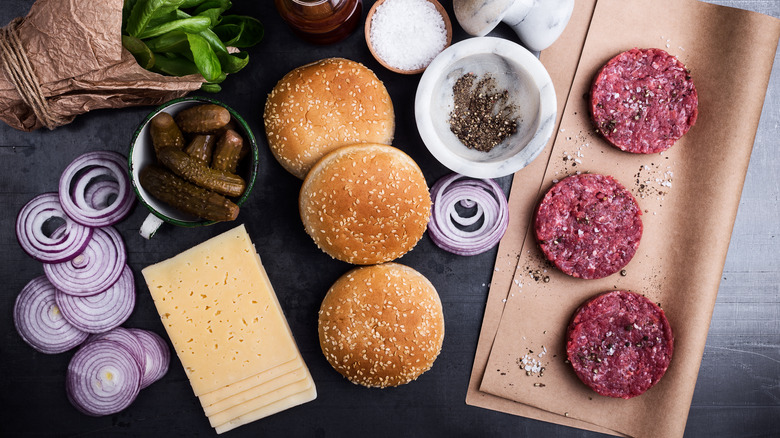Follow Gordon Ramsay's Genius Tip And Never Eat A Cold Burger Again
There's a reason Gordon Ramsay and other acclaimed chefs seem to always make an educational pilgrimage to study in France: Cooking techniques there are no joke. Mise en place, "everything in its place" in French, is the practice of prepping and organizing ingredients before you start to cook. With time-sensitive recipes, like burgers, this practice yields significant dividends since you don't have to waste precious seconds finding and preparing what you need.
Since burgers cook so quickly, there's no time to mix sauces, slice onions, or wash lettuce. Ramsay assembles all of his ingredients, from buns to toppings, in neat rows before his burgers ever touch the grill. Once the burgers are finished, he can immediately put them on their buns, top them as needed, and serve them while they're still piping hot off the grill. After all, nobody wants a cold burger when you can be prepared to ensure it stays delicious and warm. Whether it's good old lettuce and tomato or any of the secret ingredients you should be using in your burger patties, a bit of planning goes a long way.
That's the heart of mise en place — planning. Like any dish, the best basic burger recipe benefits from understanding the process, from start to finish, and incorporating each step's needs into the others. Gaining a holistic view of cooking is one of the best ways new cooks can level up their game because it minimizes mistakes, adds value to each step, and streamlines your recipes.
Other ways to prep your burgers
One of the best ways to ensure a happy grilling experience is to form your patties ahead of time and let them sit in the fridge for a few hours. Doing so sets up the meat and keeps its shape firm. It's a huge help when flipping, the step where burgers are the most likely to fall apart, and is a best practice for any burger restaurant. Be sure to take them out of the fridge and let them sit at room temperature for half an hour so they cook evenly.
Keeping a bit of melted butter on hand lets you not only give your burgers a decadent glaze but also improve your buns. Toasting the buns not only helps them soak up less juice and sauce than untoasted ones, but it also provides an extra layer of flavor to the meal. Exact cooking times may vary depending on how much your patties actually weigh. But, if you time it right, your bread will be ready at the same time as the meat, giving you a juicy, toasted burger.
Having your cheese ready and warmed up is an often overlooked element. Whether you prefer slices or shredding it yourself, having it at room temperature and ready when you need it ensures you won't have to overcook your burger to get that delicious melt over your patties. This is especially important with hard cheeses, like cheddar, as the low moisture means they need more heat to melt properly.


